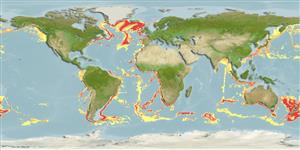Common names from other countries
>
Gadiformes (Cods) >
Moridae (Morid cods)
Etymology: Halargyreus: Greek, als = salt + Greek, argyros = silver (Ref. 45335).
More on author: Günther.
Environment: milieu / climate zone / depth range / distribution range
Ekologi
laut batipelagis; kisaran kedalaman 450 - 3000 m (Ref. 50550). Deep-water; 67°N - 60°S, 86°W - 122°W (Ref. 1371)
Spotty records from the subarctic and subantarctic to temperate waters of the Atlantic Ocean. South Atlantic: along the coast of Africa, on Walvis Ridge, near Discovery and Meteor seamounts and on the continental slope of Antarctica (Ref. 44938). Northwest Atlantic: Canada (Ref. 5951). North Pacific: northwestern Bering Sea and the Pacific Ocean south of the Gulf of Alaska to California and to Japan and the Sea of Okhotsk.
Size / Weight / umur
Maturity: Lm ? range ? - ? cm
Max length : 56.0 cm TL jantan/; (Ref. 1371)
deskripsi pendek
Kunci identifiaksi (pengenalan) | Morfologi | Morfometrik
Duri punggung (Keseluruhan (total)) : 0; duri punggung lunak (Keseluruhan (total)) : 58 - 67; Duri dubur: 0; Sirip dubur lunak: 42 - 53; vertebrata, bertulang belakang: 52 - 55. Eye large, its diameter about equal to snout length. Lower jaw slightly projecting; chin barbel absent. Elongate filament in first dorsal fin absent. Anal fin originating at about the midlength of body, deeply indented; pectoral fins not reaching to anal fin origin. Outer 2 pelvic rays elongate. Anterior gill rakers of 1st arch longer than gill filaments. Ventral light organ absent. Color is generally pale, silvery in fresh specimen; urobranchial cavity black (Refs. 1371, 43939).
Epibenthic (Ref. 58426). Food consists of free-living small animals, such as crustaceans and squids. This species is reportedly being caught by trawl in temperate waters of Australia (Ref. 9563).
Life cycle and mating behavior
Maturities | Reproduksi, perkembang biakan | Spawnings | Egg(s) | Fecundities | Larva
Cohen, D.M., T. Inada, T. Iwamoto and N. Scialabba, 1990. FAO species catalogue. Vol. 10. Gadiform fishes of the world (Order Gadiformes). An annotated and illustrated catalogue of cods, hakes, grenadiers and other gadiform fishes known to date. FAO Fish. Synop. 125(10). Rome: FAO. 442 p. (Ref. 1371)
Status IUCN Red List (Ref. 130435)
CITES (Ref. 128078)
Not Evaluated
ancaman kepada manusia
Harmless
penggunaan manusia
Perikanan: komersial
Alat, peralatan
laporan khas
muat turun XML
Sumber internet
Estimates based on models
Preferred temperature (Ref.
115969): 0.2 - 7.1, mean 3.7 (based on 813 cells).
Phylogenetic diversity index (Ref.
82804): PD
50 = 1.0000 [Uniqueness, from 0.5 = low to 2.0 = high].
Bayesian length-weight: a=0.00389 (0.00195 - 0.00776), b=3.11 (2.93 - 3.29), in cm Total Length, based on LWR estimates for this (Sub)family-body shape (Ref.
93245).
Trophic level (Ref.
69278): 3.4 ±0.47 se; based on food items.
Daya lenting (Ref.
120179): sangat rendah, Waktu penggandaan populasi minimum lebih dari 14 tahun (Preliminary K or Fecundity.).
Fishing Vulnerability (Ref.
59153): Moderate vulnerability (42 of 100).
Climate Vulnerability (Ref.
125649): Low vulnerability (11 of 100).
